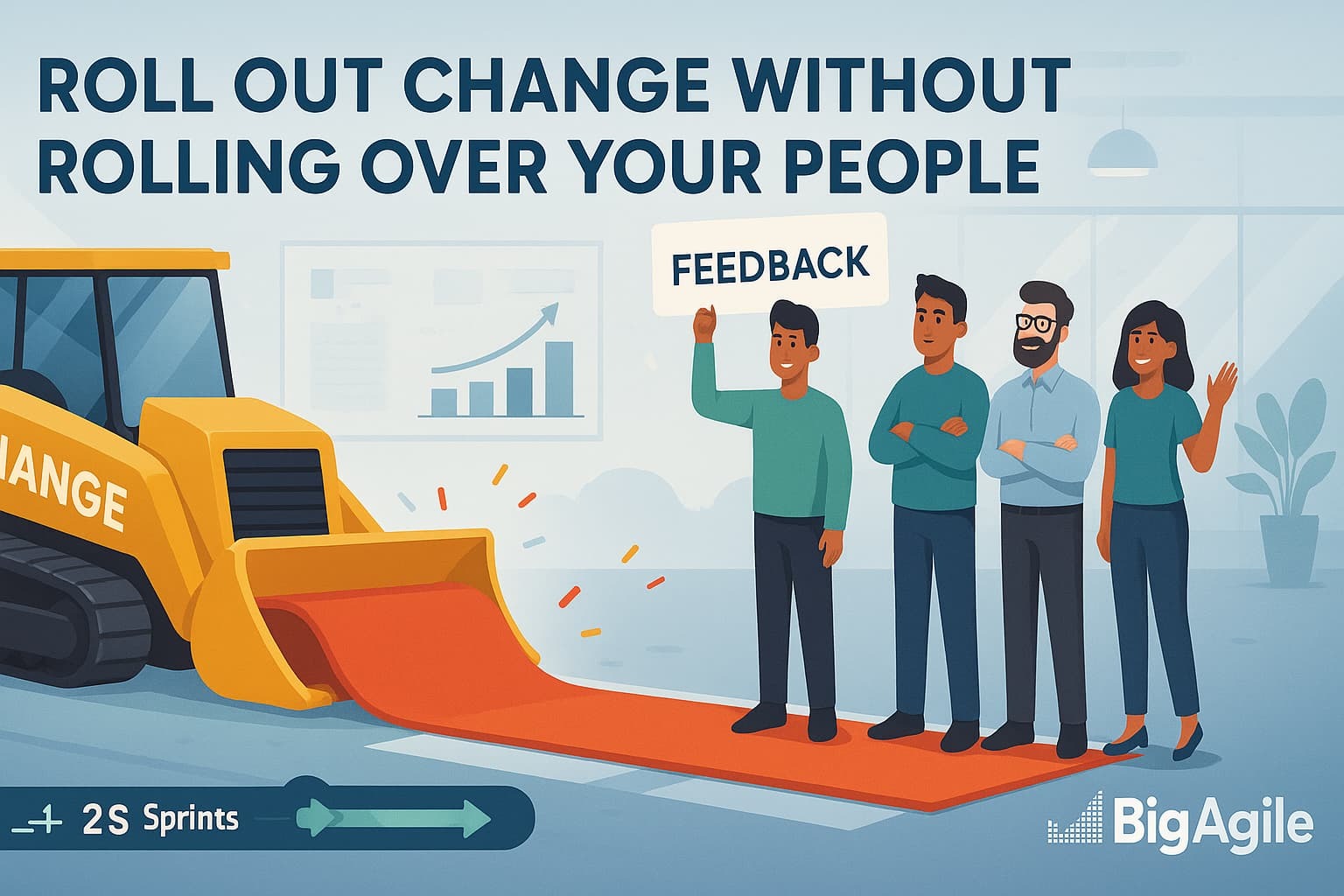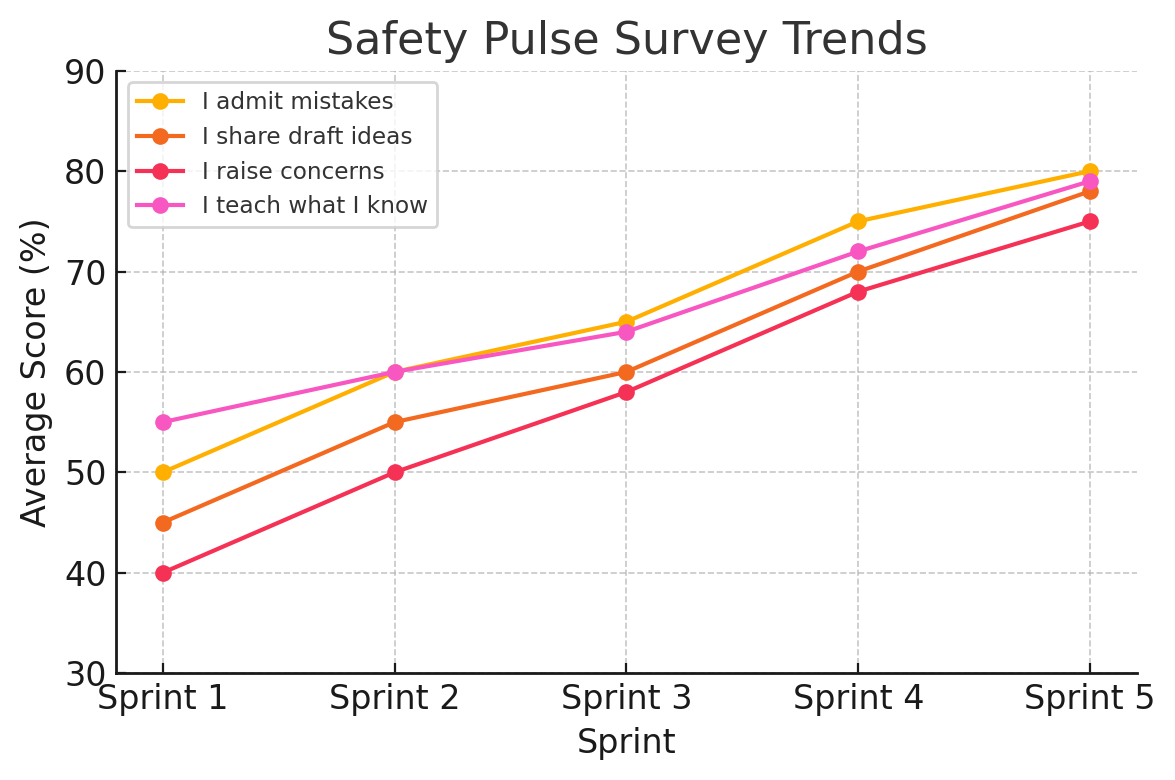
- Agile transformations often begin with excitement (a catalyzing event if done properly).
You know, a two-day certification push, a new set of tools, and a celebration of backlog migration. Then reality sets in (or what I call organizational gravity): velocity slows, Slack fills with quiet worry, and the top two engineers update their LinkedIn profiles. The issue isn’t the framework; it’s the human journey. People go through change in stages, not in sprints, and when leadership speeds up the ceremony process faster than the emotional adjustment, the outcome is stress, not progress.
I often remind leaders that people don’t necessarily dislike change; they dislike change they didn’t initiate. Change will only happen if people believe in the reason for it and see quick results. Just like diet and exercise or paying down debt, humans are all the same. Break the task into smaller steps, look for quick wins, adapt, and improve. In about three weeks, new behaviors become ingrained, strengthening the change efforts.
Kotter’s 8-step model reminds us that large-scale change only succeeds when a “volunteer army” agrees to the change. Push too hard, too fast, and that army becomes a compliance group, doing the ritual, skipping reflection. Hiatt’s ADKAR model warns that a lack in any of Awareness, Desire, Knowledge, Ability, or Reinforcement can drag down the entire effort. Still, many organizations default to big-bang rollouts, believing momentum is the same as mass, and why not? That is how we were often trained in business schools. Change is NOT immediate; a reminder of Virginia Satir's change curve:

Today we focus on the human journey, explaining why large waves of new processes overwhelm mental and emotional resources, how a retail giant changed the game with 30-minute “fear clinics,” and why small, timely interventions outperform large training plans. You’ll see evidence, not just words: a 38% reduction in attrition risk, a 22% increase in Desire scores on ADKAR pulses, and cycle-time parity within a few Sprints.
We’re halfway through our Agile with Heart series. Monday provided teams with psychological safety; Tuesday built cross-time-zone trust. Today covers the mechanics of sustainable change, ensuring that future frameworks don’t replicate today’s burnout.
What’s The Problem?
Introducing a new framework overnight can cause cognitive overload. Employees must unlearn familiar rituals while simultaneously learning to refine their backlog, estimate tasks, and establish new boundaries for their roles. Neuroscience refers to this switch as the cost, and it increases cortisol—the primary stress hormone. Prosci research shows projects with low readiness achieve only 17% of their desired outcomes; employees revert to known habits the moment coaches leave.
Second, big bangs ignore individual change stages. Kotter’s Step 4 (“Enlist the Volunteer Army”) emphasizes incremental wins to build momentum. When every squad is mandated to “be Scrum” by Q3, victories become blurry, and skepticism grows. Deloitte’s 2024 survey found that organizations that introduced changes gradually experienced 50% lower turnover than those that made company-wide changes all at once.
Finally, blanket roll-outs misallocate coaching. High-maturity teams participate in basic ceremonies, while new teams struggle with taxonomy. Coaching capacity becomes stretched thin, failing to support either group effectively. The irony is that frameworks designed to promote autonomy often feel top-down because the human learning curve is overlooked. Good intentions; bad interpretation.
Field Proof.
A Fortune 200 retailer planned to convert 14 waterfall teams to Scrum before peak season. Instead of a four-day boot camp, the Agile office introduced weekly 30-minute “fear clinics.” Any team member could anonymously submit concerns; coaches responded live with GIF-sized tactics and curated a one-page job aid. Common fears, “design docs will disappear,” “we’ll lose testing rigor,” were addressed in context, not just in theory.
Parallel ADKAR pulse surveys highlighted which stages lag. Week 2 showed Knowledge at 65% but Desire at 42%. Coaches shifted: clinics transitioned to outcome storytelling, inviting early adopters to share their successes. Desire increased to 73% by Week 6. Attrition remained flat; no exodus despite peak-season pressure. Within a few Sprints, the cycle time matched the previous waterfall rate and then accelerated. The cost? Six hours of coach time per team, spread across the entire quarter.
Three Micro-Interventions.
| Intervention | How to Run | ADKAR Stage Boosted |
|---|---|---|
| 30-Min Fear Clinic | Anonymous Q&A in Slack every Thursday; coach answers live with GIF-size tips. | Awareness → Desire |
| Just-Enough Job Aid | Link one-page cheat sheet (splitting, DoR, pointing) to the clinic thread; update weekly. | Knowledge → Ability |
| ADKAR Pulse Survey | 4-question Google Form each sprint; chart trends publicly, act on reds. | Reinforcement |
Getting Started.
Step 1: Launch the clinic. Choose a catchy name—like “Ask Me Anything Agile.” Keep it to 30 minutes, webcam optional, Slack friendly. Seed the first session with two FAQs to break the ice.
Step 2: Pair each question with a micro-aid. Concerned about story pointing? Share a one-page cheat sheet directly from Essential Scrum. Confused about DoR? Post a 90-second Loom demo. The rule: the resource must be consumable in under five minutes.
Step 3: Track your change curve. Create a four-item Google Form that matches the ADKAR stages. Send it out on Friday, publish scores on Monday. Celebrate green, address red. Guidelines: Keep responses anonymous and comments optional (to reduce form fatigue).
Step 4: Make your progress visible. Display clinic attendance and pulse trends in the sprint review deck. When teams see Desire rising and attrition remaining flat, skepticism begins to fade. Leaders can then redirect coaching hours to struggling squads, creating a positive feedback loop that fosters improvement.

Early signs of success include clinics filling up without prompting, Desire pulse improving, and blockers shifting from “Scrum process” to typical technical debt. Maintain this trajectory, and burnout remains steady, even as the backlog continues to evolve rapidly.
What Good Looks Like.
The Fear Clinic Slack thread is buzzing even before the meeting begins; ADKAR pulse charts glow greener with each sprint; and stand-ups no longer stall on “How do we do this in Scrum?” but focus on real engineering challenges. Attrition stays steady during the heaviest release season, and new hires learn the framework from peers rather than PDFs. Most tellingly, sprint reviews highlight change wins,“Cycle time down two days since we eliminated waterfall hand-offs,” right next to product demos. The transformation story shifts from mandate to momentum.
Monday demonstrated that psychological safety accelerates velocity; Tuesday showed how empathy rituals bond remote teams; and Wednesday showed how microskills can help overcome impediments. Today we’ve learned how compassionate, digestible coaching prevents big changes from eroding that hard-earned trust.
Tomorrow, we’ll wrap up the series with real-world stories where a human-centric approach has boosted both morale and customer value, such as Joy-Flow radars replacing burndowns and eNPS rising alongside increased release frequency. Stay tuned; the best stories are yet to come, as those will come from YOUR teams :)